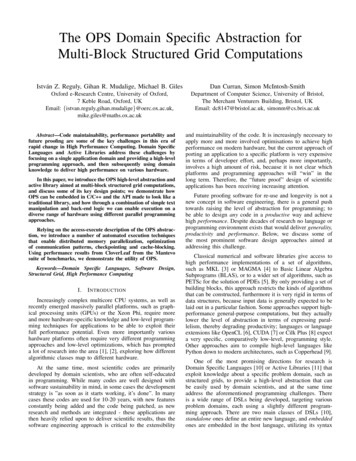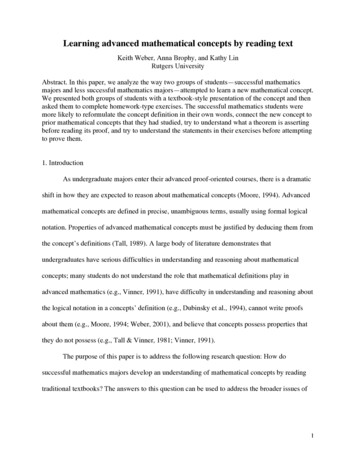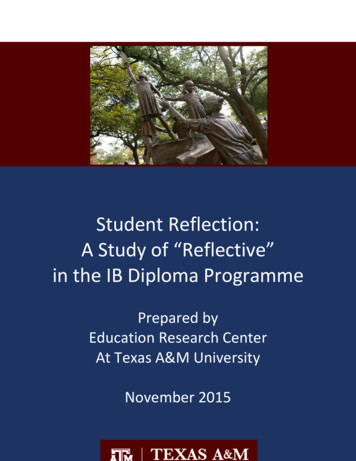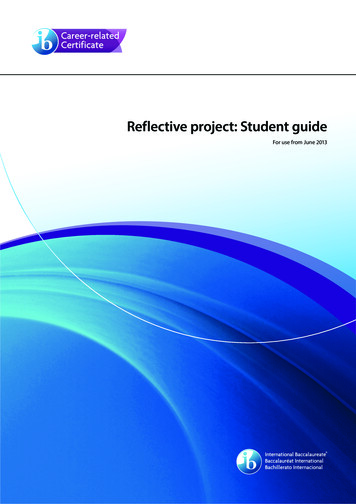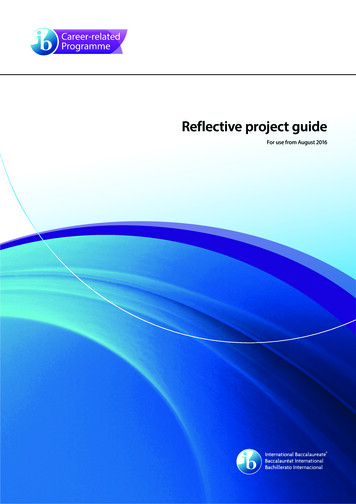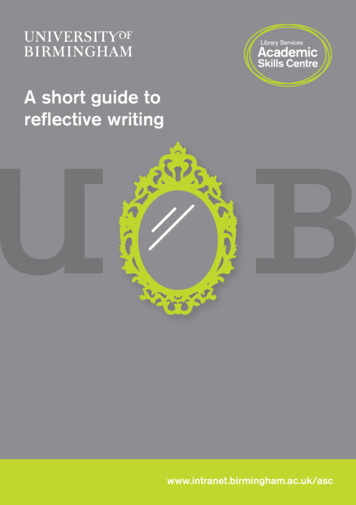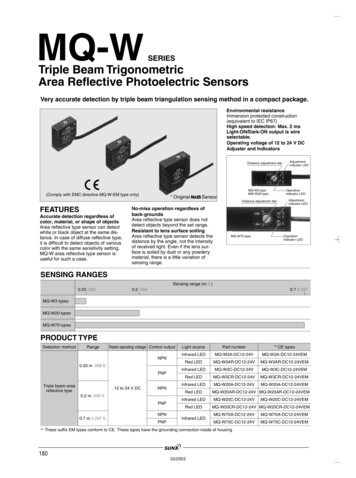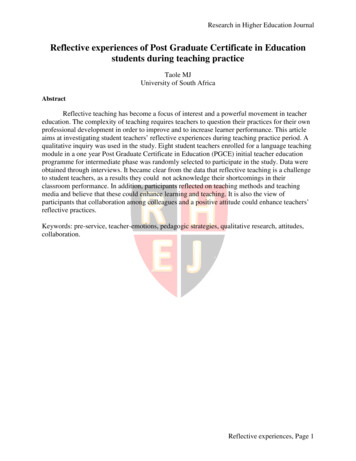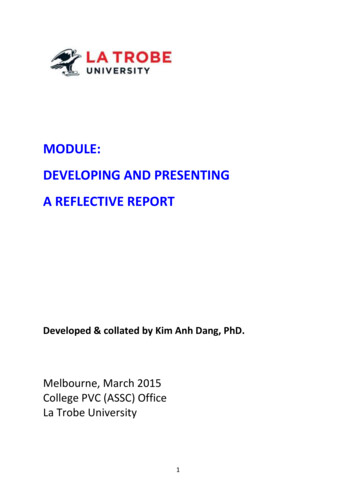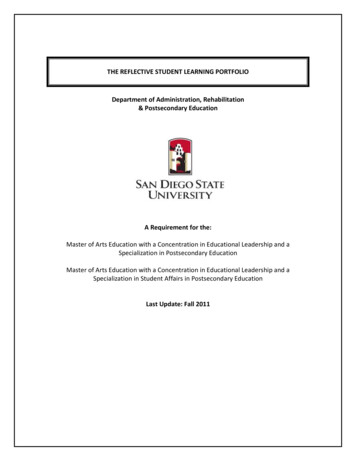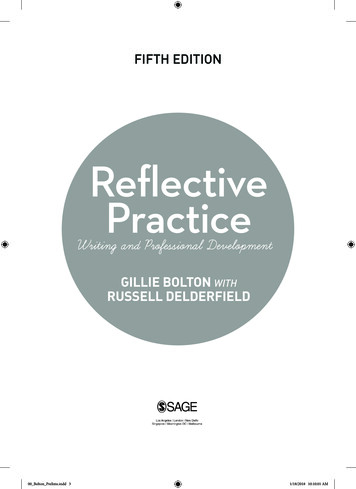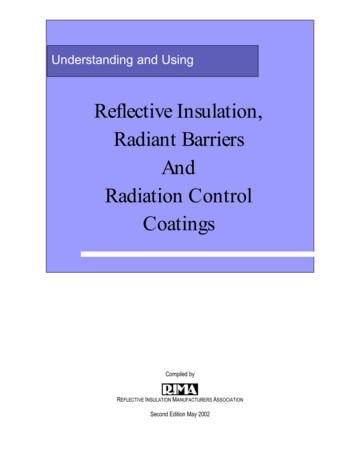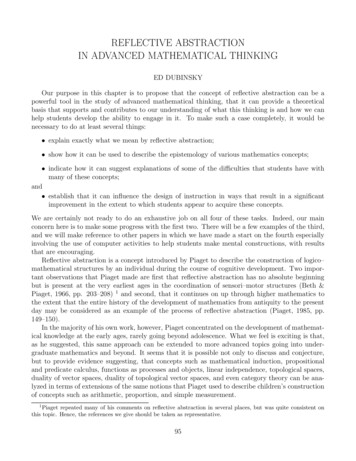
Transcription
REFLECTIVE ABSTRACTIONIN ADVANCED MATHEMATICAL THINKINGED DUBINSKYOur purpose in this chapter is to propose that the concept of reflective abstraction can be apowerful tool in the study of advanced mathematical thinking, that it can provide a theoreticalbasis that supports and contributes to our understanding of what this thinking is and how we canhelp students develop the ability to engage in it. To make such a case completely, it would benecessary to do at least several things: explain exactly what we mean by reflective abstraction; show how it can be used to describe the epistemology of various mathematics concepts; indicate how it can suggest explanations of some of the difficulties that students have withmany of these concepts;and establish that it can influence the design of instruction in ways that result in a significantimprovement in the extent to which students appear to acquire these concepts.We are certainly not ready to do an exhaustive job on all four of these tasks. Indeed, our mainconcern here is to make some progress with the first two. There will be a few examples of the third,and we will make reference to other papers in which we have made a start on the fourth especiallyinvolving the use of computer activities to help students make mental constructions, with resultsthat are encouraging.Reflective abstraction is a concept introduced by Piaget to describe the construction of logico–mathematical structures by an individual during the course of cognitive development. Two important observations that Piaget made are first that reflective abstraction has no absolute beginningbut is present at the very earliest ages in the coordination of sensori–motor structures (Beth &Piaget, 1966, pp. 203–208) 1 and second, that it continues on up through higher mathematics tothe extent that the entire history of the development of mathematics from antiquity to the presentday may be considered as an example of the process of reflective abstraction (Piaget, 1985, pp.149–150).In the majority of his own work, however, Piaget concentrated on the development of mathematical knowledge at the early ages, rarely going beyond adolescence. What we feel is exciting is that,as he suggested, this same approach can be extended to more advanced topics going into undergraduate mathematics and beyond. It seems that it is possible not only to discuss and conjecture,but to provide evidence suggesting, that concepts such as mathematical induction, propositionaland predicate calculus, functions as processes and objects, linear independence, topological spaces,duality of vector spaces, duality of topological vector spaces, and even category theory can be analyzed in terms of extensions of the same notions that Piaget used to describe children’s constructionof concepts such as arithmetic, proportion, and simple measurement.1Piaget repeated many of his comments on reflective abstraction in several places, but was quite consistent onthis topic. Hence, the references we give should be taken as representative.95
This is a strong claim embodied in the phrase “can be analyzed” and, before going further, it isnecessary to explain what sort of analysis we mean. The goal of our study of reflective abstractionis a general framework which can be used, in principle, to describe any mathematical concepttogether with its acquisition. We refer to this as a general theory of mathematical knowledge andits acquisition. This is the first ingredient of the analysis, but it does not, by itself, lead to anyparticular description. In addition, the investigator needs to make use of her or his understandingof the mathematics. Together these two are enough to obtain a description of any concept but theresult would be far too ex post facto to expect it to have any relation to how students actually mightgo about constructing the concept. A third and essential ingredient in the study of any conceptis a long drawn–out, time consuming effort of observation of students as they try to constructmathematical concepts in order to make sense out of situations in which they find themselves(presumably, but not necessarily, as the result of activities of a teacher). The analysis then consistsof a synthesis of these three ingredients brought to bear on the question of how a particular topicin mathematics may be learned. The starting point of our general theory is Piaget’s notion ofreflective abstraction. Unfortunately, this is not a simple idea clearly explained in one place, butrather something that Piaget appeared to work with over a long period of time after he completedhis empirical studies of children in development. It is important, however, that we begin with a solidunderstanding of what he meant by it before trying to extend it to a wider class of mathematicaltopics. Therefore we begin this chapter with a section that gives a brief summary of this conceptas Piaget elaborated it in a number of books and papers, mostly written in the last 15 years of hislife. We will emphasize the construction aspects of reflective abstraction because these are the mostimportant for the development of mathematical thought during adolescence and beyond.In the second section we will show how Piaget’s ideas can be extended and reorganized toform a general theory of mathematical knowledge and its acquisition which is applicable to thosemathematical ideas that begin to appear at the post–secondary level and continue to be constructedin the course of mathematical and other scientific research. It is here, in §2 that we relate variousaspects of the general theory to specific topics in advanced mathematical thinking and give severalexamples of how reflective abstraction can suggest explanations of student difficulties.Our analysis of a particular mathematical concept leads to what we call a genetic decompositionof the concept which is a description, in terms of our theory, and based on empirical data, ofthe mathematics involved and how a subject might make the constructions that would lead toan understanding of it (which, in our theory, are not very different). It is important to notethat we do not suggest that a concept has a unique genetic decomposition or that this is theway every subject will learn it. We only claim that observations of learning in progress form animportant source for our genetic decompositions and we offer them as a guide for one possible wayof designing instruction. In §3 we present genetic decompositions for three concepts: mathematicalinduction, predicate calculus, and function, insofar as we have constructed them. The referencesgiven in §3 contain more information about examples of instructional treatments based on thesegenetic decompositions, using computer experiences, and about the generally encouraging resultsof implementing these treatments.Finally, in §4 we discuss some of the educational implications of our theory of knowledge andlearning and give an overview of how we go about designing an instructional treatment based on it.We feel that the material in this section is very much akin to the ideas in Thompson (1985a).96
1. PIAGET’S NOTION OF REFLECTIVE ABSTRACTION1.1 THE IMPORTANCE OF REFLECTIVE ABSTRACTIONPiaget distinguished three major kinds of abstraction. Empirical abstraction derives knowledgefrom the properties of objects (Beth & Piaget, 1966, pp.188–189). We interpret this to mean thatit has to do with experiences that appear to the subject to be external. The knowledge of theseproperties is, however, internal and is the result of constructions made internally by the subject.According to Piaget, this kind of abstraction leads to the extraction of common properties of objectsand extensional generalizations, that is, the passage from “some” to “all”, from the specific to thegeneral (Piaget & Garcia, 1983, p. 299). We might think, for example of the color of an object, orits weight. These properties might be considered to reside entirely in the object but one can onlyhave knowledge of them by doing something (looking at the object in a certain light, hefting it)and different individuals under different conditions might come to different conclusions about theseproperties.Pseudo–empirical abstraction is intermediate between empirical and reflective abstraction andteases out properties that the actions of the subject have introduced into objects (Piaget, 1985,pp.18–19). Consider, for example the observation of a 1–1 correspondence between two sets ofobjects which the subject has placed in alignment (ibid, p. 39). Knowledge of this situation maybe considered empirical because it has to do with the objects, but it is their configuration in spaceand relationships to which this leads that are of concern and these are due to the actions of thesubject. Again, of course, understanding that there is a 1–1 relation between these two sets is theresult of internal constructions made by the subject.Finally, reflective abstraction is drawn from what Piaget (1980, pp. 89–97) called the generalcoordinations of actions and, as such, its source is the subject and it is completely internal. Wewill see many instances of reflective abstraction, but a very early example we can mention nowis seriation, in which the child performs several individual actions of forming pairs, triples, etc.,and then interiorizes and coordinates the actions to form a total ordering (Piaget, 1972, pp. 37–38). This kind of abstraction leads to a very different sort of generalization which is constructiveand results in “new syntheses in midst of which particular laws acquire new meaning” (Piaget &Garcia, 1983, p. 299). An example of this is the concept of euclidean ring which is certainly anabstraction and generalization. It might be considered, however, to derive from the properties of asingle example–the integers.We can see, therefore, that these different kinds of abstraction are not completely independent.The actions that lead to pseudo–empirical and reflective abstraction are performed on objects whoseproperties the subject only comes to know through empirical abstraction. On the other hand,empirical abstraction is only made possible through assimilation schemas which were constructedby reflective abstraction (Piaget, 1985, pp. 18–19). Consider, for example a physics experimentwhich may have the purpose of making an empirical abstraction to obtain factual data about acertain object. The experiment presupposes, however, an enormous range of logico–mathematicalpreliminaries – in deciding how to pose the question, in the construction of apparatus for “indirectobservations” (e.g., triangulation to obtain distances between stars), in the use of particular formsof measurement, and finally, in setting out the results in logico–mathematical language. All ofthese are concepts that must have been constructed using reflective abstraction. (Piaget, 1980, p.97
91). This mutual interdependence can be roughly summarized as follows. Empirical and pseudo–empirical abstraction draws knowledge from objects by performing (or imagining) actions on them.Reflective abstraction interiorizes and coordinates these actions to form new actions and, ultimatelynew objects (which may no longer be physical but rather mathematical such as a function or agroup). Empirical abstraction then extracts data from these new objects through mental actionson them, and so on. This feedback system will be reflected in our extension of these ideas in thenext section.In empirical abstraction the subject observes a number of objects and abstracts a common property. Pseudo–empirical abstraction proceeds in the same way, after actions have been performed onthe object. Reflective abstraction, however, is much more complicated. This is not surprising since,according to Piaget, “The development of cognitive structures is due to reflective abstraction. . . ”(Piaget, 1985, p. 143). Before going into the nature of this fundamental process, therefore, weshould say a few things about its importance, in Piaget’s view, to cognitive thought in general andmathematics in particular.In two books Piaget (1976, 1978) interpreted the results of many experiments with childrenin terms of reflective abstraction. But its role is not restricted to the intellectual developmentof children. From Piaget’s psychological viewpoint, new mathematical constructions proceed byreflective abstraction (Beth & Piaget, 1966, p. 205). Indeed, he considered it to be the methodby which all logico–mathematical structures are derived (Piaget, 1971, p. 342); and that “it alonesupports and animates the immense edifice of logico–mathematical construction” (Piaget, 1980, p.92).In support of his position on the role of reflective abstraction in advanced mathematical thinking,Piaget tried to explain a number of major mathematical concepts in terms of the constructions thatresult from this psychological process. These included the idea of Gödel’s incompleteness theorem(Beth & Piaget, 1966, p. 275), the abstract concept of groups (1980, p. 19), Bourbaki’s attempts toencompass all of mathematics within three “mother structures” (1970a, p. 24), the general theoryof categories (Piaget 1970b, p. 28), the impossibility of constructing the set of all sets (1970b, pp.70–71), and the mathematical concept of function (Piaget et al, 1977, p. 168). More generally,Piaget considered that it is reflective abstraction in its most advanced form that leads to the kindof mathematical thinking by which form or process is separated from content and that processesthemselves are converted, in the mind of the mathematician, to objects of content (Piaget, 1972,pp. 63–64 and pp. 70–71).Returning to the ideas of Piaget, it is important to emphasize that there is no suggestion herethat all (or any) of the advanced mathematics described above is actually done by any kind ofdirect application (conscious or otherwise) of reflective abstraction. This was not Piaget’s purposein trying to analyze that aspect of thinking. The point, rather, is that when properly understood,reflective abstraction appears as a description of the mechanism of the development of intellectual thought. It is important for Piaget’s theory that this same process that describes advancedmathematical thinking appears in cognitive development throughout life from the child’s very firstcoordinations that lead to concepts such as number, measurement, multiplication, and proportion(Piaget, 1972, pp. 70–71). An important ingredient of Piaget’s general theory (on which he workedfor 60 years) that relates biological evolution to the development of intelligence is the idea that reflective abstraction is one isolated case of certain very general processes that are found throughoutliving creation (Piaget, 1971, p. 331).98
1.2 THE NATURE OF REFLECTIVE ABSTRACTIONAs we have seen, reflective abstraction differs from empirical abstraction in that it deals withaction as opposed to objects and it differs from pseudo–empirical abstraction in that it is concerned,not so much with the actions themselves, but with the interrelationships among actions, whichPiaget (1976, p. 300) called “general coordinations”.According to Piaget, the first part of reflective abstraction consists of drawing properties frommental or physical actions at a particular level of thought (Beth & Piaget, 1966, pp. 188–189).This involves, amongst other things, cognizance or consciousness of the actions (1971, p. 320). Itcan also include the act of separating a form from its content (1972, pp. 63–64). Whatever is thus“abstracted” is projected onto a higher plane of thought (1985, pp. 29–31) where other actions arepresent as well as more powerful nodes of thought.It is at this point that the real power of reflective abstraction comes in for, as Piaget observes,one must do more than dissociate properties from those which will be ignored or separate a formfrom its content (1975a, p. 206). There is “a process which will become increasingly evident overtime: the construction of new combinations by a conjunction of abstractions” (Piaget, 1972, p. 23).Piaget seemed to feel that this construction aspect of reflective abstraction is more importantthan the abstraction (or extraction) aspect (ibid, p. 20). Not only did he assert, as we observedearlier, that construction of this kind is the essence of mathematical development, and that combining formal structures is a natural extension of the development of thought (ibid, p. 64), buthe also used his analysis of this process to deal with the philosophical question of the nature ofmathematical thought (Beth & Piaget, 1966).Certainly for our purposes, the construction aspect of reflective abstraction will play the majorrole.1.3 EXAMPLES OF REFLECTIVE ABSTRACTIONIN CHILDREN’S THINKINGWe begin with some of Piaget’s examples of reflective abstraction in logico–mathematical thinkingat the earlier ages. This is important because of his insistence on the continuity of development aspart of his search for a single process or set of processes that related to biological development aswell as intellectual development (Piaget, 1971, p. 331). Our suggestion in this chapter is that thespecific construction processes that can be used to build sophisticated mathematical structures canbe found, already, in the thinking of young children.commutativity of addition. The discovery that the number of objects in a collection is independent of the order in which the objects are placed requires first that the child count theobjects, reorder them, count them again, reorder and count, etc. Each of these actions areinteriorized and represented internally in some manner so that the child can reflect on them,compare them, and realize that they all give the same result (Piaget, 1970a, pp. 16–17).number. According to Piaget (1941), the concept of number is constructed by coordinating thetwo schemas of classification (construction of a set in which the elements are units, indistinguishable from each other) and seriation (which, as we observed earlier, is itself a coordinationof the various actions of pairing, tripling, etc.).99
trajectory. The traversal of a path is understood as a coordination of successive displacementsto form a continuous whole (Piaget, 1980, p. 90).see–saw. The balancing of objects on two sides of a see–saw by a combination of actions onboth sides involves more than just keeping two things in mind at the same time. Because heobserved a considerable delay between the time that a child could create the balance and thetime that the child appeared to understand how he or she had done it, Piaget saw this as acoordination of two actions into a single system (Piaget, 1978, p. 96).multiplication. Both psychologically and mathematically, multiplication is the addition ofadditions. It is, however, objects that are added in the sense that addition is an operationapplied to something. In order, therefore, to multiply, it is necessary first to encapsulate the(mental) action of addition into an object (or set of objects) to which addition can be applied(Piaget, 1985, p. 31).fluid levels. In an experiment asking children to predict the level to which a known amount offluid would rise in a vessel with sloping sides and markings at equal height divisions (Piaget etal, 1977, chapter 7). Piaget pointed out that this situation is a case of “variation of variations”.That is, the differential in two vertical markings is a variation, but the amount of change alsovaries because of the sloping sides. Hence, the first variation must become an object to whichan action is applied (sloping sides) resulting in a higher order variation.1.4 VARIOUS KINDS OF CONSTRUCTIONIN REFLECTIVE ABSTRACTIONIn considering the above examples of reflective abstraction as methods of construction, we canisolate four different kinds which will be important for advanced mathematical thinking. We add afifth which Piaget considers at length, but was not, for him, part of reflective abstraction. With the appearance of the ability to use symbols, language, pictures, and mental images, thechild performs reflective abstractions to represent (Piaget, 1970a, p. 64), that is, to constructinternal processes as a way of making sense out of perceived phenomena. Piaget called thisinteriorization (1980, p. 90) and referred to it as “translating a succession of material actionsinto a system of interiorized operations” (Beth & Piaget, 1966, p. 206). The commutativityof addition described above is one example of this. (See also Thompson, 1985a, p. 197.) Several of our examples such as trajectory and see–saw involve the composition or coordinationof two or more processes to construct a new one. This is to be distinguished from Piaget’sphrase, “general coordinations of actions” which refers to all ways of using one or more actionsto construct new actions or objects. Multiplication, proportion and variation of variation exemplify the construction which is perhaps the most important (for mathematics) and most difficult (for students). This is encapsulation or conversion of a (dynamic) process into a (static) object. As Piaget put it (1985,p. 49), “. actions or operations become thematized objects of thought or assimilation”. He100
considered that “The whole of mathematics may therefore be thought of in terms of the construction of structures,. mathematical entities move from one level to another, an operationon such ‘entities’ becomes in its turn an object of the theory, and this process is repeateduntil we reach structures that are alternately structuring or being structured by “stronger’structures” (Piaget, 1972, p. 70). From a philosophical point of view, Piaget was applyingthe idea of encapsulation to the relativity between form and content when he referred to“.building new forms that bear on previous forms and include them as contents” and “reflective abstractions that draw from more elementary forms the elements used to constructnew forms” (Piaget, 1985, p. 140). When a subject learns to apply an existing schema to a wider collection of phenomena, then wesay that the schema has been generalized. This can occur because the subject becomes awareof the wider applicability of the schema. It can also happen when a process is encapsulated toan object as, for example, the ratio of two quantities, or addition, so that an existing schemasuch as equality or addition can then be applied to it to obtain, respectively, proportion ormultiplication. The schema remains the same except that it now has a wider applicability. Theobject changes for the subject in that he or she now understands that it can be assimilatedby the extended schema. Piaget referred to all of this as a reproductive or generalizingassimilation (1972, p. 23), and he called the generalization extensional (Piaget & Garcia,1983, p. 299). Once a process exists internally, it is possible for the subject to think of it in reverse, notnecessarily in the sense of undoing it, but as a means of constructing a new process whichconsists of reversing the original process. Piaget did not discuss this in the context of reflectiveabstraction, but rather in terms of the INRC group. We include it as an additional form ofconstruction.2. A THEORY OF THE DEVELOPMENT OF CONCEPTSIN ADVANCED MATHEMATICAL THINKING2.1 OBJECTS, PROCESSES, AND SCHEMASAlthough, as we have pointed out, Piaget believed that reflective abstraction was as important forhigher mathematics as it was for children’s logical thinking, his research was mainly concerned withthe latter. In order to try to develop the notion of reflective abstraction for advanced mathematicalthinking, we will isolate what seem to be the essential features of reflective abstraction, reflect ontheir role in higher mathematics, and reorganize or reconstruct them to form a coherent theory ofmathematical knowledge and its construction.For us, reflective abstraction will be the construction of mental objects and of mental actionson these objects. In order to elaborate our theory and relate it to specific concepts in mathematics,we will use the notion of schema. A schema is a more or less coherent collection of objects andprocesses. A subject’s tendency to invoke a schema in order to understand, deal with, organize, ormake sense out of a perceived problem situation is her or his knowledge of an individual conceptin mathematics. Thus an individual will have a vast array of schemas. There will be schemas forsituations involving number, arithmetic, set formation, function, proposition, quantification, proof101
by induction, and so on throughout all of the subject’s mathematical knowledge. Obviously, theseschemas must be interrelated in a large, complex organization. For example, there will be a proofschema, which can include a schema for proof by induction. This latter in turn could include aschema for proposition valued functions of the positive integers (see p. 112). Hence there would bea relation with the schemas for number, for function, and for proposition. On the other hand, thereis a sense in which a proof is an action applied to a proposition, so that the proof schema might beone of the processes in the proposition schema.We will also sometimes use the term process or mental process instead of mental action when weare emphasizing its internal (to the subject) nature. Finally the term object will refer to a mentalor physical object (avoiding any discussion of the nature of the distinction).One of our goals in elaborating the general theory is to isolate small portions of this complexstructure and give explicit descriptions of possible relations between schemas. When this is donefor a particular concept, we call it a genetic decomposition of the concept. We should also point outthat although we only give, for each concept, a single genetic decomposition, we are not claimingthat this is the genetic decomposition, valid for all students. Rather it represents one reasonableway that students might use to construct a concept.It is not easy to separate a description of mathematical knowledge from its construction. AsPiaget put it, “. the problem of knowledge, the so-called epistemological problem, cannot beconsidered separately from the problem of the development of intelligence” (Piaget,1975a, p. 166).It is not possible to observe directly any of a subject’s schemas or their objects and processes.We can only infer them from our observations of individuals who may or may not bring them tobear on problems – situations in which the subject is seeking a solution or trying to understanda phenomenon. But these very acts of recognizing and solving problems, of asking new questionsand creating new problems are the means (in our opinion, essentially the only means) by which asubjectconstructs new mathematical knowledge.This is where reflective abstraction comes in. Thus, although we might say that mathematicalknowledge consists of a collection of schemas, we have little to say about how that knowledge existsinside a person. It does not seem to reside in memory or in a physiological configuration. All we cansay is that a subject will have a propensity for responding to certain kinds of problems in a relatively(but far from totally) consistent way which we can (as far as our theory has been developed) describein terms of schemas. When the subject is successful, we say that the problem has been assimilatedby the schema. When the subject is not successful then, in favorable conditions, her or his existingschemas may be accommodated to handle the new phenomenon. This is the constructive aspect ofreflective abstraction to which we referred as forming the main object of our concern.In this sense, the study of reflective abstraction is complementary to investigation of notionssuch as epistemological obstacles as studied by Cornu (1983), and Sierpinska (1985a, 1985b) orthe conflict between concept image and concept definition as investigated by Schwarzenberger &Tall, 1978; Tall & Vinner, 1981; Dreyfus & Vinner, 1982; Vinner, 1983; Tall, 1986a; Vinner &Dreyfus, 1989. One can think of reflective abstraction as trying to tell us what needs to happenwhereas the other notions attempt to explain why it does not. It is possible that our idea of usingcomputer experiences (Ayers et al, 1988; Dubinsky, 1990a, 1990b) to help students make reflectiveabstractions can be a way of dealing with these obstacles and conflicts. But these are matters forother investigators and other papers.102
2.2 CONSTRUCTIONS IN ADVANCED MATHEMATICAL CONCEPTSIn the previous section, we isolated five kinds of construction that Piaget found in the development of children’s logical thinking: interiorization, coordination, encapsulation, generalization,and reversal. We will reconsider each of them in the context of advanced mathematical thinking todescribe how new objects, processes and schemas can be constructed out of existing ones.Some of the following examples will apply to a single one of the five kinds of construction andothers will apply to a combination of two or more of them. Some of the statements we make arebased on observations of students and others are only suppositions, derived as a preliminary toobservations, from the general theory and our knowledge of the mathematics.As we make these statements about constructions that we have seen students appear to makeor that our investigations suggest they need to make, or as we conjecture that certain conceptscould be constructed in these ways, the reader should be aware that we are not suggesting that itis automatic, natural, or easy for students to take these steps. An important aspect of the wholeproblem of education that we do not consider in this paper is to explain why stunts do or do notmake these particular constructions and what can be done to help them. This is an important issuefor research in mathematics education.An important part of understanding a function that we have observed is to construct a process(Dubinsky
mathematical ideas that begin to appear at the post{secondary level and continue to be constructed in the course of mathematical and other scienti c research. It is here, in x2 that we relate various aspects of the general theory to speci c topics in advanced
